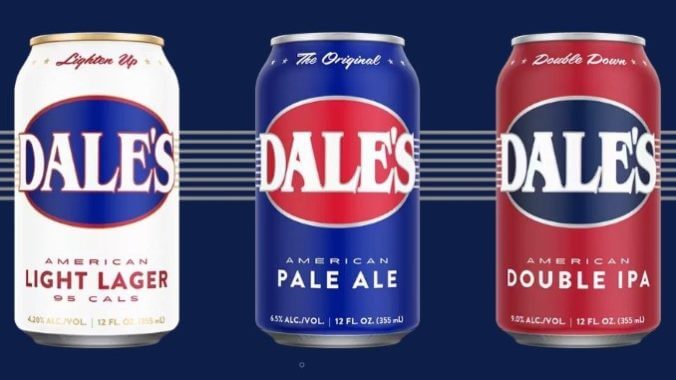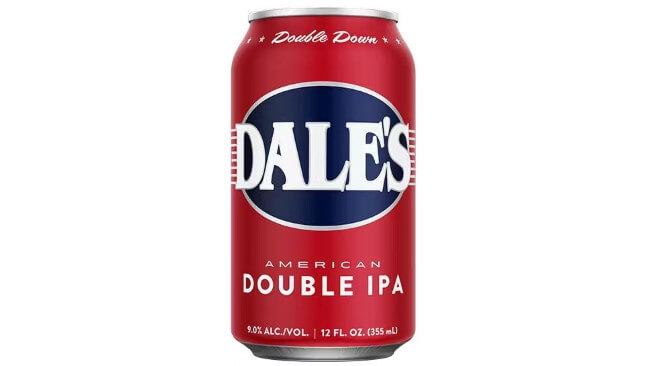Tasting: Revisiting the Full Oskar Blues Dale’s Beer Lineup
Photos via Oskar Blues
Just 20 years ago, if you had reached into your fridge for any beer produced by a small, independent brewery, there’s a roughly 99.99% chance that brew would have been coming out of a glass bottle. In fact, even 10 years ago, the craft beer world had yet to fully embrace every aspect of canning their wares–where some styles such as IPA had eagerly made the leap to the canned packaging format, most breweries were loath to be the first in line to migrate styles such as barrel-aged imperial stout to the aluminum-walled 12 or 16 oz can. In reality, the mass adoption of cans in the craft beer world was a phenomenon that might never have come to pass at all, if not for Oskar Blues Brewery, and their genre-defining flagship Dale’s Pale Ale.
It seems likely that a number of small breweries had dabbled in the art of canning craft beer in the years before Oskar Blues first released the iconic, blue and red cans of Dale’s. But none of them provided the kind of visibility that Dale’s did when it first arrived in 2002, nor were other breweries prepared to fight the mental hurdle that canned craft beer represented in this time. Those who got interested in beer in the last decade may struggle to believe there was an era where cans were heavily stigmatized in the craft (or “microbrew,” as so many said at the time) world, but this was a very real stumbling block to be overcome. Because craft breweries had long defined themselves in oppositional terms to the “macro” beer world, demonizing all the iconography of “Big Beer” had been going on for decades, and no aspect of beer was more representative of the dominant, watery American light lagers than the choice of 12 oz cans as a packaging format. Therefore, beer geeks of the era had likely come into the hobby hearing a constant refrain that aluminum cans were a substandard method of packaging, believing that they contributed metallic or “tinny” flavors to beer. This was an assumption that took years to reverse, and it was forever Dale’s leading the charge, making a case for the convenience and portability that cans could offer to craft beer fans. Other breweries slowly began to get on board in the 2000s, helped along by efforts such as Oskar Blues’ own Burning Can festival, which gave other companies exploring canned craft beer a place to congregate and share knowledge.
Two decades later, I don’t need to tell you that the scene has been entirely transformed. Cans are now the dominant form of craft beer packaging, with bottles–especially large format bottles, which were once everywhere–having moved to the fringes, often reserved for styles such as barrel-aged stout and wild ales. The 16 oz can has become ubiquitous, intimately associated with the proliferation of hazy, juicy IPA. Oskar Blues has subsequently grown into a large regional presence as part of CANarchy, itself acquired by Monster Beverage Corp in 2022. Recent years have been a mixed bag, as the brewery has won plaudits for developments such as its water conservation efforts, while simultaneously facing many of the same pitfalls that other mid-sized craft breweries have struggled with. Just last week, Oskar Blues unexpectedly closed its Austin taproom, a reminder of how the post-pandemic craft beer market has left even the scene’s well-known brewers decidedly vulnerable to market forces. It’s hard to know what to expect for the future.
One thing that hasn’t changed, though: Dale’s Pale Ale. The beloved brew is still much the same as ever, although Oskar Blues has subsequently expanded the “Dale’s” lineup to include two other beers, a light lager and a double IPA version of the original Dale’s. As all three of these beers received something of a branding refresh in 2023, this seemed like a good time to go back and actually taste how Dale’s–all versions of what is now “Dale’s”–fits in the modern beer world.
So with that said, let’s get to tasting.
Oskar Blues Dale’s Pale Ale
ABV: 6.5%

One of the great ironies of Dale’s Pale Ale is that this beer has for a few decades been one of the most cited examples of American pale ale as a style, when at 6.5% ABV it never really fit that definition particularly well, at least as far as an organization like the Beer Judge Certification Program would define it. Especially at the time it was first released, this beer really read more like an India pale ale of its day, complete with what was once considered a requisite malt backbone. It actually may fit better in the pale ale category today than it ever did then, given that malt flavors have almost completely disappeared in the IPA world, but are ever-so-slightly more welcome in beers now labeled as “pale ale.” Regardless, this is an unusually strong take on pale ale, hopped with a classic trifecta of Cascade, Centennial and Comet, arguably an underused classic varietal.
On the nose, the original Dale’s is distinctly malty, with sweet, toasty notes, florals and slightly perfumey hop character. You get hints of Grape Nuts with the deeper toasted malt, with additional bread crust, tilting the nose slightly in the direction of cereal grains. This is likely somewhat disconcerting to the modern drinker who is so used to the balance always being 100% in favor of hops in any “hoppy” style. On the palate here, Dale’s is malty sweet, with traces of caramel, bread crust, and hints of dark fruit from the malt, transitioning into light grassy and citrusy hops and mild to moderate bitterness. Each sip transitions toward dryness on the finish, and it actually reads as ever-so-slightly alcohol-forward in the flavor, something that many drinkers once considered a feature. Overall, this is a throwback in all respects, a malt-forward pale ale of the sort that is increasingly difficult to find on store shelves. It’s a solid, versatile beer that no one would mistake for say, modern IPA.
Oskar Blues Dale’s Light Lager
ABV: 4.2%

When you think about it, this current Dale’s lineup doesn’t just illustrate how much the American craft beer drinker’s perception of canned beer has changed–it likewise indicates how differently drinkers feel now about the very idea of lager or “light lager” than they would have 20 years ago when Dale’s Pale Ale was first released. Likewise widely demonized in those earlier craft beer days as bland, watery beer not worth drinkers’ time, these crisp, lighter lagers have instead become one of craft beer’s fastest-growing areas in the last half decade, as craft brewers have diversified and sought to compete more directly against the macro lagers they once reviled. Most of the bigger, regional craft brewers now have at least one year-round light lager in their arsenal, so it makes perfect sense to see one under the Dale’s banner, even if the brand was originally built on hops and malt.
On the nose, Dale’s Light Lager has a lightly fruity bouquet. There is subtle bready grain, with mildly floral and perhaps lightly tropical hop character, but it’s clearly intended to not be a beer that needs puzzling over. On the palate, this one is lightly doughy in the malt department, with some floral and slightly buzzy herbal hops, and a subtle fruitiness that evokes white grape. It features a modest grainy sweetness, but finishes crisp and dry as you would expect it to. You certainly get the sense it’s supposed to be an unassuming, everyday lager, and that’s exactly how it presents.
Oskar Blues Dale’s Double IPA
ABV: 9%

Given the iconic status of Dale’s Pale Ale over the years, I was always sort of surprised that Oskar Blues didn’t capitalize on a “Double Dale’s” sooner. It seems like a brand that would have existed for at least a decade or more at this point, rather than having been introduced in 2022. It’s not as if Oskar Blues hasn’t brewed other double/imperial IPAs, after all–presumably, they were just saving the “Double Dale” title for something that fit the mold, and finally released it as part of their 20th anniversary celebrations last year. It certainly has a certain stature to it, at 9% ABV. The hop bill, meanwhile, is actually entirely different from the original Dale’s, featuring El Dorado, Nelson Sauvin and Talus.
On the nose, the big brother to the original Dale’s is somewhat more expressively fruity than the prior beer, with notes of orange marmalade and stone fruit joining the grassy and floral notes. Not to be lost is the toasted malt sweetness and bread crust, which still provides more or less a 1:1 balance with the hop profile. On the palate, the bitter orange marmalade comes forward again, along with pronounced florals, sweet malt, Grape Nuts, crisp grain, and fresh grassy and lightly piney, resinous hops. It’s backed by lingering, moderately intense bitterness and a little drying sensation, with moderately assertive ethanol that feels just about right for the task.
Honestly, I find this one to be comfortingly old school even though it’s a relatively more recent recipe, with modern hop varietals. The malt presence and bitter balance combine nicely with its level of hop assertiveness, making for a total package that feels like catching up with an old friend. I would quite like it if there were more DIPAs in this mold on store shelves in 2023, but it’s good to know that the Dale’s brand is continuing to fly its particular, iconoclastic flag.
Jim Vorel is a Paste staff writer and resident beer and liquor geek. You can follow him on Twitter for more drink writing.







































